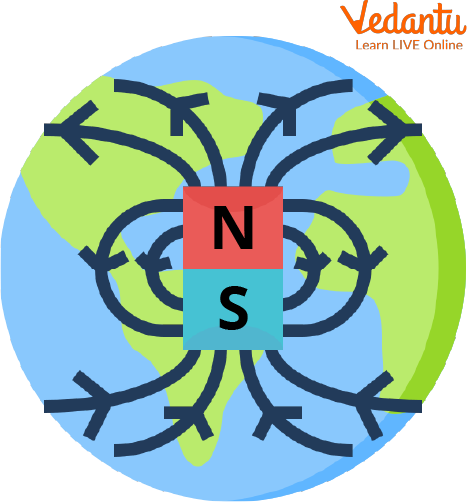




How Does Magnetism Work? Principles, Uses & Everyday Applications
Were you surprised too when you first saw how a magnet works? It’s not magic, it’s science! Let’s learn about the properties of magnetism and what a magnetic field is. A magnet is a piece of metal or rock that pulls specific kinds of metals towards itself. The force or field of magnets is called magnetism. There are three types of magnets - temporary magnets, permanent magnets, and electromagnets.
Temporary magnets - when the magnetic force is removed, the object gradually loses its magnetism. Once permanent magnets are magnetised, they do not easily lose their magnetism. Electromagnets are used when a really strong magnet is needed.
Magnetic Force - Definition
Magnetic force is caused due to the motion of charges. The north poles and south poles are attracted to each other. Unlike poles attract each other. Plastic, rubber, water, glass, or non-magnetic materials are not attracted toward a magnet. Objects such as nails, nuts, screws, and rods are magnetic materials, hence they are attracted to magnets. Objects that are rich in iron, cobalt, and nickel are strongly attracted to magnets. Scientists call these metallic elements ‘ferromagnetic’ because of their strong attraction.
Earth’s Magnetism (Properties of Magnetism)

Earth’s Magnetic Field
The region surrounding a magnet, where magnetism can be traced, is called the region’s magnetic field. The Earth possesses a magnetic field, it works as if a permanent bar magnet is fitted inside it.
The Earth is like one massive magnet. The Earth’s core is a mix of iron and nickel which gives it its very own magnetic field. Magnets are really useful, they are used to make a tight seal between the frame of a refrigerator and its door. Magnets are also used for storing data in computers. They power speakers in devices such as headphones and stereos.
What Makes a Magnet?
Inside a piece of steel are large numbers of tiny magnetic regions called domains. These domains are mixed up so that their effects cancel out and the steel does not get magnetised. If the domain points in the same direction, the steel turns into a magnet. The end that the north poles of the domains point towards becomes a north pole and the other end is a south pole.
Aurora - A Beautiful Phenomenon

Aurora Responds to Earth’s Magnetic Field
The Earth’s magnetic poles attract charged particles emitted by the Sun. When the particles clash with other gas particles in the atmosphere, coloured light gets radiated.
What are the Uses of a Magnet?
Magnetic Tape
A cassette tape contains plastic tape with a coating of iron oxide or chromium dioxide. Magnetic patterns can be applied to the tape by the head of a tape recorder. This causes a change in electrical sound signals, turning them into a magnetic field which induces patterns of magnetism on the tape. While replaying, the magnetised tape causes electrical signals in the head. These are reproduced as sound.
Burglar Alarm:
On the door, a permanent magnet is mounted. A reed switch is mounted on the door frame. When the door is in the closed position, the magnet causes the upper two magnetic iron strips to cling together. When the door is opened by the burglar, the magnet moves away and the centre strip gets sprung back. It touches the non-magnetic contact below, completing the circuit and activating the alarm.
Electromagnetism:
Many things around us, such as speakers, electric bells, horns, and motors, use electricity to make magnetism. An electric current always produces a magnetic force. A magnet created in this way is called an electromagnet; magnetism made in this way is called electromagnetism.
Summary
A magnet works over a distance - it doesn’t need to touch an object to attract (pull) it. A magnet has a north pole and a south pole, both. The magnetic force of magnets flows from the north pole toward the south pole. If you try to push the south poles of two magnets together, they repel each other. Two north poles also repel each other, which means like poles repel each other.
FAQs on Magnetism Explained: Key Concepts & Real-Life Examples
1. What is magnetism in simple terms?
Magnetism is a natural force that causes certain materials to attract or repel each other. This force is generated by an invisible area called a magnetic field, which is created by the movement of electric charges. Materials like iron, nickel, and cobalt are strongly affected by this force and are known as magnetic materials.
2. What are the basic properties of a magnet?
A magnet has several fundamental properties that define its behaviour:
- Attractive Property: Magnets pull ferromagnetic materials, such as iron and steel, towards them.
- Directive Property: When allowed to hang or float freely, a magnet will always align itself in a North-South direction, which is the principle behind a compass.
- Like Poles Repel, Opposite Poles Attract: Every magnet has a North pole and a South pole. Two North poles or two South poles will push each other away, while a North pole and a South pole will pull together.
- Poles Exist in Pairs: It is impossible to have a magnet with only one pole. If you break a magnet in half, you create two smaller magnets, each with its own North and South pole.
3. What is the difference between magnetic and non-magnetic materials?
The key difference lies in how they respond to a magnetic field. Magnetic materials, like iron, steel, nickel, and cobalt, are strongly attracted to a magnet. In contrast, non-magnetic materials, such as wood, plastic, paper, rubber, and glass, show no attraction to a magnet and are not affected by its magnetic field.
4. How were magnets first discovered?
The discovery of magnets dates back to ancient times. The first natural magnets were found in a region of ancient Greece called Magnesia. People there discovered a type of rock, later named lodestone, that could naturally attract iron-containing objects. The term 'magnet' originates from Magnesia, the place of its initial discovery.
5. How can you make a temporary magnet at home?
You can create a temporary magnet using the stroking method. Take an iron object, like a nail or a sewing needle, and a strong permanent magnet. Stroke the nail with one pole of the magnet, moving from one end to the other in a single, consistent direction. Lifting the magnet away at the end of each stroke and repeating this process around 40-50 times will align the domains inside the nail, temporarily magnetising it.
6. How does a magnetic compass work to show directions?
A magnetic compass works because the Earth itself acts like a giant magnet with its own North and South magnetic poles. The compass contains a small, lightweight magnetised needle that can rotate freely. This needle aligns itself with the Earth's magnetic field, causing its North-seeking pole to always point towards the Earth's geographic North Pole, thus providing a reliable sense of direction.
7. Why can't a magnet have just a single pole?
A magnet cannot have a single isolated pole (also known as a magnetic monopole) because magnetism is created by the alignment of tiny magnetic domains that inherently have both a north and a south end. If you cut a bar magnet in half, you will not get a separate North pole and South pole. Instead, you will end up with two new, smaller magnets, and each piece will have its own North and South pole.
8. What are electromagnets and what makes them so useful?
An electromagnet is a type of magnet where the magnetic field is produced by an electric current. It is typically made by wrapping a coil of wire around an iron core. The primary advantage of an electromagnet over a permanent magnet is that its magnetic force can be turned on or off by controlling the electricity. Its strength can also be easily adjusted. This control makes them vital for devices like electric motors, speakers, and industrial cranes that lift and drop scrap metal.
9. How do maglev trains use magnetism to float and move?
Maglev (Magnetic Levitation) trains use the principle of magnetic repulsion to float. Powerful electromagnets are installed on both the bottom of the train and along the guideway (track). These magnets are arranged so that like poles face each other (e.g., North vs. North). The resulting strong repulsive force is powerful enough to lift the entire train, eliminating friction with the track. A different set of magnets then creates a shifting magnetic field that pulls and pushes the train forward at high speeds.









